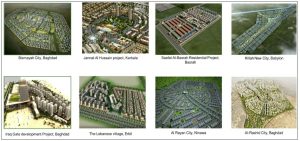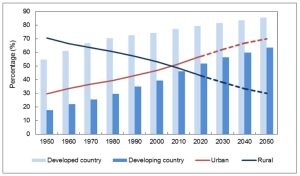Environmental Challenges of Sustainable Urban Development (ECSUD)
Dr Raed Fawzi Mohammed Ameen
Lecturer at Architecture Department College of Engineering Karbala University
Environmental challenges of urban development become recently a global issue due to the negative impacts on the environment and populations all over the world.
Due to the rise in population in urban areas, cities have become the main source of contributors to local, territorial and global ECSUD. According to an accredited international report (UNDESA (2010)), which pointed out the urban population reached up to 3.5 billion in 2010, this number is expected to double by 2050 (Figure 1). Thus, the ECSUD, such as climate change, energy resources, water availability, waste recycling, pollution, sanitation and infrastructure will grow and exacerbate to be one of the most urgent problems facing the world. Natural disasters, wars, corruption and economic downturn, could pose external and internal factors influencing the production of the ECSUD.
Figure 1: The projected urban and rural population percentages and rate of urbanization in developed and developing countries from 1950- 2050
Consequently, many reports pointed out that many cities especially in developing countries have been affected by unprecedented population growth as well as other factors. Therefore, cities will be facing tremendous, uncontrollable and unpredictable environmental challenges shortly. Hence, it is important to identify ECSUD and their priority and deal with the time frames related to appropriate solutions to cope with the local urban challenges. Moreover, some organizations, such as: The Urban Management Programme (UMP); The Metropolitan Environmental Improvement Program (MEIP), and The Urban Management Programme (UMP). They developed and applied new approaches in Asia, Africa and South America. They suggested new directions depending on global experience, to tackle and mitigate several ECSUD deficits and improve the lives of people. They were concentrating on strengthening the capability of countries to treat urban problems in many critical areas, such as urban land management; maintenance of urban infrastructure; promoting integration and optimization of water supply and sanitation services; pollution control and the protection of the urban environment.
Iraqi cities also suffered from destruction and degradation for more than four decades. Due to previous wars and international sanctions, affecting the economy and infrastructures. Related publications, including The Iraq National Development Plan (2013-2017) had identified the ECSUD of Iraqi cities, which were represented by: air, water and soil pollution; shortage of water resources; desertification; lack of waste recycling and reuse; untreated contaminated areas; efficient infrastructure; and the absence of sustainable development.
Rebuilding and rehabilitation are, therefore, essential while establishing new urban areas, housing projects and cities to meet the growing demand (Figure 2). With the new oil boom and economic prosperity, there is also an emerging desire towards an improved standard of living.




























































